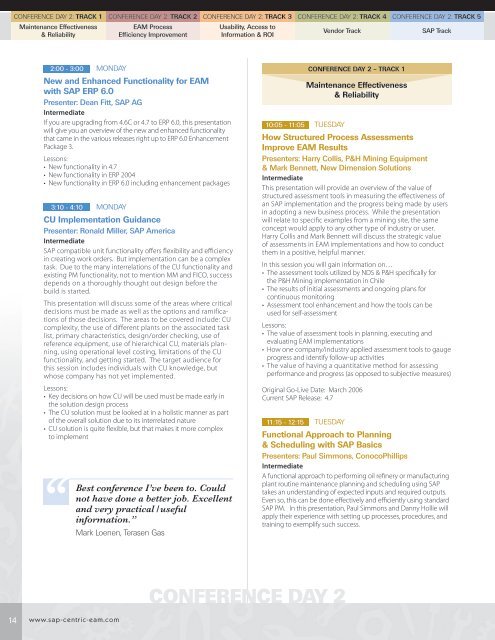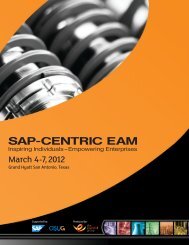March 30 – April 2, 2008 - SAP-Centric EAM
March 30 – April 2, 2008 - SAP-Centric EAM
March 30 – April 2, 2008 - SAP-Centric EAM
Create successful ePaper yourself
Turn your PDF publications into a flip-book with our unique Google optimized e-Paper software.
1<br />
CONFERENCE DAY 2: TRACK 1<br />
Maintenance Effectiveness<br />
& Reliability<br />
2:00 - 3:00 MONDAY<br />
New and Enhanced Functionality for <strong>EAM</strong><br />
with <strong>SAP</strong> ERP 6.0<br />
Presenter: Dean Fitt, <strong>SAP</strong> AG<br />
Intermediate<br />
If you are upgrading from 4.6C or 4.7 to ERP 6.0, this presentation<br />
will give you an overview of the new and enhanced functionality<br />
that came in the various releases right up to ERP 6.0 Enhancement<br />
Package 3.<br />
Lessons:<br />
• New functionality in 4.7<br />
• New functionality in ERP 2004<br />
• New functionality in ERP 6.0 including enhancement packages<br />
3:10 - 4:10 MONDAY<br />
Cu Implementation Guidance<br />
Presenter: Ronald Miller, <strong>SAP</strong> America<br />
Intermediate<br />
<strong>SAP</strong> compatible unit functionality offers flexibility and efficiency<br />
in creating work orders. But implementation can be a complex<br />
task. Due to the many interrelations of the CU functionality and<br />
existing PM functionality, not to mention MM and FICO, success<br />
depends on a thoroughly thought out design before the<br />
build is started.<br />
This presentation will discuss some of the areas where critical<br />
decisions must be made as well as the options and ramifications<br />
of those decisions. The areas to be covered include: CU<br />
complexity, the use of different plants on the associated task<br />
list, primary characteristics, design/order checking, use of<br />
reference equipment, use of hierarchical CU, materials planning,<br />
using operational level costing, limitations of the CU<br />
functionality, and getting started. The target audience for<br />
this session includes individuals with CU knowledge, but<br />
whose company has not yet implemented.<br />
Lessons:<br />
• Key decisions on how CU will be used must be made early in<br />
the solution design process<br />
• The CU solution must be looked at in a holistic manner as part<br />
of the overall solution due to its interrelated nature<br />
• CU solution is quite flexible, but that makes it more complex<br />
to implement<br />
“<br />
www.sap-centric-eam.com<br />
CONFERENCE DAY 2: TRACK 2<br />
<strong>EAM</strong> Process<br />
Eff iciency Improvement<br />
Best conference I’ve been to. Could<br />
not have done a better job. Excellent<br />
and very practical /useful<br />
information.”<br />
Mark.Loenen,.Terasen.Gas<br />
CONFERENCE DAY 2: TRACK 3<br />
Usability, Access to<br />
Information & ROI<br />
CONFERENCE DAY 2: TRACK 4<br />
Vendor Track<br />
10:05 - 11:05 TUESDAY<br />
How Structured Process Assessments<br />
Improve <strong>EAM</strong> Results<br />
Presenters: Harry Collis, P&H Mining Equipment<br />
& Mark Bennett, New Dimension Solutions<br />
Intermediate<br />
This presentation will provide an overview of the value of<br />
structured assessment tools in measuring the effectiveness of<br />
an <strong>SAP</strong> implementation and the progress being made by users<br />
in adopting a new business process. While the presentation<br />
will relate to specific examples from a mining site, the same<br />
concept would apply to any other type of industry or user.<br />
Harry Collis and Mark Bennett will discuss the strategic value<br />
of assessments in <strong>EAM</strong> implementations and how to conduct<br />
them in a positive, helpful manner.<br />
In this session you will gain information on…<br />
• The assessment tools utilized by NDS & P&H specifically for<br />
the P&H Mining implementation in Chile<br />
• The results of initial assessments and ongoing plans for<br />
continuous monitoring<br />
• Assessment tool enhancement and how the tools can be<br />
used for self-assessment<br />
Lessons:<br />
• The value of assessment tools in planning, executing and<br />
evaluating <strong>EAM</strong> implementations<br />
• How one company/industry applied assessment tools to gauge<br />
progress and identify follow-up activities<br />
• The value of having a quantitative method for assessing<br />
performance and progress (as opposed to subjective measures)<br />
Original Go-Live Date: <strong>March</strong> 2006<br />
Current <strong>SAP</strong> Release: 4.7<br />
11:15 - 12:15 TUESDAY<br />
CONFERENCE DAY 2<br />
CONFERENCE DAY 2 — TRACK 1<br />
Maintenance Effectiveness<br />
& Reliability<br />
CONFERENCE DAY 2: TRACK 5<br />
<strong>SAP</strong> Track<br />
Functional Approach to Planning<br />
& Scheduling with <strong>SAP</strong> basics<br />
Presenters: Paul Simmons, ConocoPhillips<br />
Intermediate<br />
A functional approach to performing oil refinery or manufacturing<br />
plant routine maintenance planning and scheduling using <strong>SAP</strong><br />
takes an understanding of expected inputs and required outputs.<br />
Even so, this can be done effectively and efficiently using standard<br />
<strong>SAP</strong> PM. In this presentation, Paul Simmons and Danny Hollie will<br />
apply their experience with setting up processes, procedures, and<br />
training to exemplify such success.



